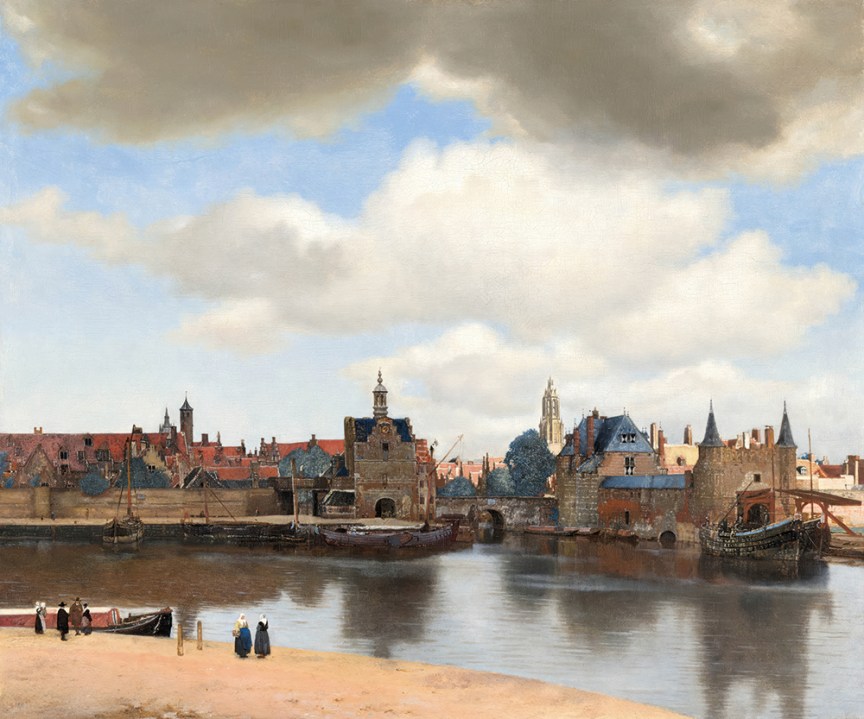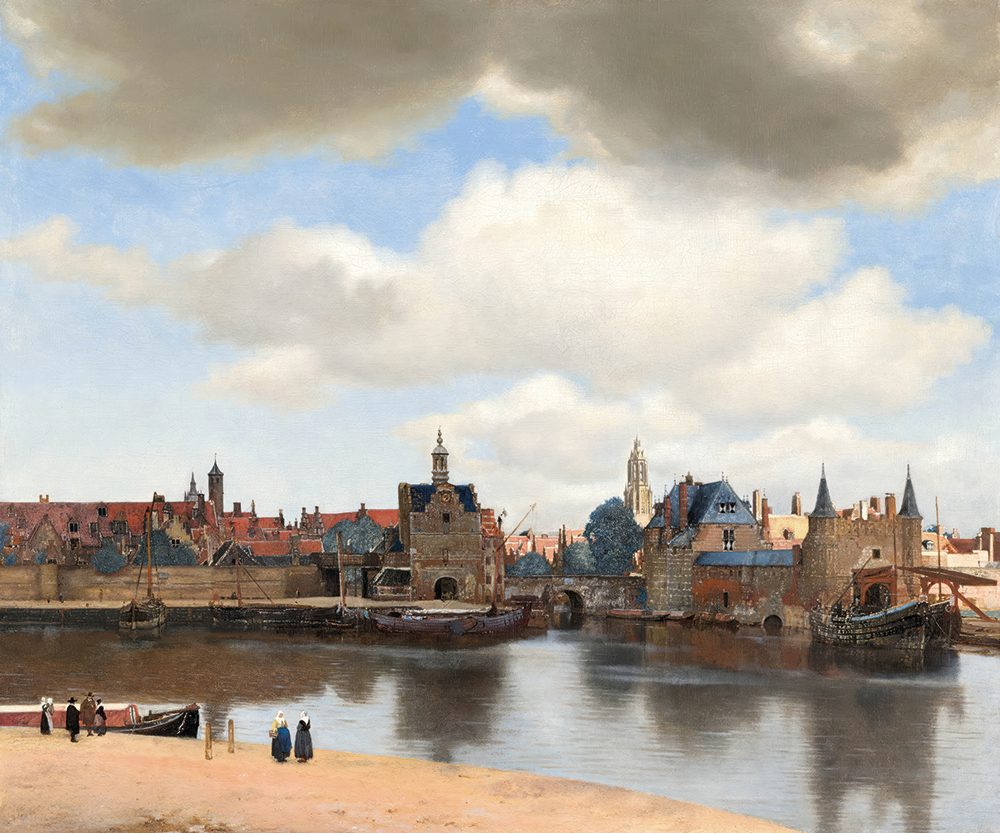
The Delft painter Johannes Vermeer, now probably the most beloved artist of the Dutch Golden Age, had an unusual career. His reputation in his lifetime was small. For some reason he painted almost exclusively for the van Ruijvens, so only those who knew the family would have been able to view much of the work. One foreign observer who did see a painting owned by a baker (probably handed over in security for a large overdue account) was incredulous at what the owner claimed was the value of a small picture by an unknown artist.
After Vermeer’s death, and the sale of the collection for very little on the death of his patrons’ son-in-law, his name disappeared. He is hardly ever mentioned in any of the exhaustive and insightful 18th-century histories of Dutch painting. It is not much of an exaggeration to say that he was a painter created by his first public admirers – the French critics of the mid-19th century.
Did they find an artist in their own mould? Golden Age flower paintings are very specific in meaning, as an excellent study by Paul Taylor has demonstrated. They are different from Chardin or Fantin-Latour’s celebrations of unmeaning physicality. Proust has Swann writing a monograph about Vermeer, indicating his advanced taste, while his novelist character Bergotte struggles from his deathbed to see the patch of yellow wall a critic has noticed in ‘View of Delft’, a painting Bergotte knows well.
Andrew Graham-Dixon thinks it unlikely that Proust would have called that cityscape the most beautiful picture in the world if he had thought it ‘just a representation of some buildings seen across a stretch of dullish water’. But that is an absurd misreading of Proust, who saw the ineffably transcendent in the rigorous transcription of physical phenomena. Proust needed no divine presence in the knock of the teaspoon on china. The first admirers of Vermeer saw a celebrant of the worldly, not a painter of allegories and annunciations. And there he has pretty much stayed – as someone who shows us the rapture of light falling on cloth.
Graham-Dixon’s biography attempts to return Vermeer to his own period, no longer effectively a contemporary of Manet. The Dutch Golden Age was a time of vehement theological debate, often bloodily pursued, and resting on a furious denunciation of the Catholicism of former Spanish rulers. Vermeer belonged to a particularly generous ecumenical sect, the Remonstrants, who admitted a wide range of beliefs – his wife’s family were actually Roman Catholic. His patrons were pillars of the Remonstrants. Were the Vermeers they amassed treated as religious icons in their circle? Dutch painting of the period is very thin in explicitly religious imagery compared with previous schools of art. Are these works in fact disguised images of devotion?
The first admirers of Vermeer saw a celebrant of the worldly – not a painter of allegories and annunciations
There is merit in many of Graham-Dixon’s readings. For instance, it seems plausible that some religious imagery enters into the probable pair of ‘The Milkmaid’ (Martha) and the ‘Woman With a Balance’ perhaps weighing souls in her scales. There are, too, some paintings from later in Vermeer’s short career which must be regarded in the light of philosophical statements, for example ‘The Astronomer’, ‘The Geographer’ and his very unsatisfactory ‘Allegory of the Catholic Faith’, whose theological substance was, uniquely, acknowledged in catalogues soon after the painter’s death.
But does this argue in favour of Graham-Dixon’s suggestions that seemingly innocent works showing women playing virginals are actually about divine grace? Or does it suggest that Vermeer, who could never have painted profitable large group portraits of massed dignitaries like Frans Hals, was trying a completely new direction to attract the attention of more than one patron?
Certainly other paintings are pushed into a completely implausible theological straitjacket. How can ‘View of Delft’ be considered a vision of the life to come, like John Bunyan’s heavenly city? Women caught in happy moments – one falling asleep after drinking, others evidently reading love letters with pleasure and excitement – are repeatedly claimed by Graham-Dixon to be contemplating their religious redemption. This seems anachronistic,and somehow puts Vermeer’s works on the level of such Pre-Raphaelite classics as William Holman Hunt’s ‘The Awakening Conscience’.
Also, there is no evidence that they were ever interpreted in such an unusual way at the time. A French Jesuit-educated traveller, Balthasar de Monconys, did manage to see a Vermeer, which must have been the ‘Young Woman with a Water Pitcher’ now in the Metropolitan in New York. He asked what it was worth, and it is true that the absurd figure he was told may have indicated that Vermeer did not want to sell the painting to a Jesuit zealot. However, if, as Graham-Dixon argues, this work is actually a portrayal of the Woman of Samaria in the Bible, is it not likely that a highly intelligent and devout connoisseur of art such as Monconys would have made some acknowledgement in describing it? Or did he just see, like most of us, a beautiful domestic image of a servant that he liked enough to consider buying?
Nor is this a case of the religious meaning being concealed. A later visitor to Vermeer’s atelier, the art collector Pieter Teding van Berkhout, a co-religionist, greatly admired what he was shown, but only as ‘curiosities’ and marvels of ‘perspective’. There is no indication that he saw any of what Graham-Dixon insists on. But, we are told, ‘he probably had far more detailed and interesting thoughts about the artist’s paintings that he simply never wrote down’. With respect, that is a pretty weak submission.
Even when one follows the trail of supposed evidence, the thesis fails to convince. Graham-Dixon claims that the ‘Girl with a Pearl Earring’ is in fact a portrayal of Mary Magdalene. He says that the model is aged 12 or 13 and must be a girl whom Vermeer knew well. The painting is known to have been executed at a time when the van Ruijvens’ daughter Magdalena was also 12 years old, ergo… But there is an established iconography of Mary Magdalene. She often looks harrowed and anguished; most consistently, she wears her hair loose. In painters of an iconographic bent, she carries a jar of ointment. None of this is the case in the Vermeer. Pearls are frequently associated with purity and virginity – not very appropriate in the case of the Magdalene. But most damagingly, Vermeer’s figure certainly doesn’t look 12. The determination to identify her as Magdalena van Ruijven has overcome plausible observation. The elegant headdress and above all the socking great pearl are not those of a child incongruously dressing up. This is a grown woman on the verge of marriage.
Graham-Dixon is an experienced and diligent writer on art, and the book contains much absorbing factual information about Vermeer’s mysterious life and his circle, with sound deductions about his family. But there is a surprising lack of judgment when it comes to talking about the paintings and their presentation as puzzles which have at last been solved.
The fact is that Vermeer is terribly diminished if you insist on explaining him as a purveyor of allegory. Not only that, but the whole art of painting suffers from the suggestion that a picture becomes greater if it has some philosophical significance. Some wonderful works no doubt do have nobility of meaning; but some may be perfectly idiotic – the Tiepolos in Würzburg aren’t any less magnificent for portraying what they apparently believe about life on four continents. Other masterpieces are about nothing much – the greatest Stubbs, Watteaus, Manets and Matisses are really just renderings of substance, flesh and pleasure. And perhaps Vermeer’s first French critics were right, and there is in him no more than that.
In any case I feel that a critic who dwells (perhaps wrongly) on the inexplicable rapture one feels in front of ‘View of Delft’ gets closer to the heart of things than one who insists (perhaps rightly) that we are being shown a particular theological understanding of the afterlife. If anything rises off Vermeer it is humility; and the humble admission that the magic before his own eyes can only be rendered, not explained, is one that we can only share in a quiet shrug.









Comments